What is the value of companies promoting Flow State?

With many companies adjusting to being back in the office or a hybrid work model, employees are having to change their Flow State. What is a Flow State? (Sometimes just called Flow.) Flow is simply that state of mind in which we feel and perform our best and feel at ease. We all have systems or processes that make it naturally easier for us to access Flow. We can, however, also we can take steps that can allow us to access it.
Switching up work environments over the past year and a half has facilitated many employees having to adjust how the access their Flow State. What is the value of companies promoting Flow State? How has the changing work model impacted Flow? And how can you access your Flow State and increase productivity?
What is Flow?
Your Flow State is what is happening mentally when you are “in the zone.” It’s being fully engaged in a task. Flow was first identified and popularized by psychology researcher, Mihaly Csikszentmihalyi, from Claremont Graduate University in California. Everyone’s Flow State is different is directly connected to their effort and creativity. When you are in your Flow State, you brain is locked into process and knows exactly what it is going to do from one moment to the next.
What is the value of companies promoting Flow State?
Flow State sounds abstract and kind of like a fuzzy motivation tool. How can it actually benefit companies? The main way is that when employees are in their Flow State, they are doing their best work. Not only that, employees who work in a Flow State often gain greater satisfaction from their work and a that contributes to motivation and company loyalty. While working in a Flow State, employees have more concentrate and focus and therefore, less distractions. The clarity that comes form that leads to innovation. All of these things are qualities that make up exceptional employees.
Flow State can be broken by distraction. Employee distraction is also detrimental to companies. Microsoft’s 2020 WFH study found that before the pandemic, on average, workers felt like 52% of their day was wasted by distractions and unnecessary disturbances. A 2013 study found that employees who were frequently interrupted and dealt with a lot a distractions reported higher fatigue and burnout rates. Burnt out employees are more likely to make mistakes, call in sick, as well as look for new jobs. (As we’ve seen this year with The Great Resignation.)
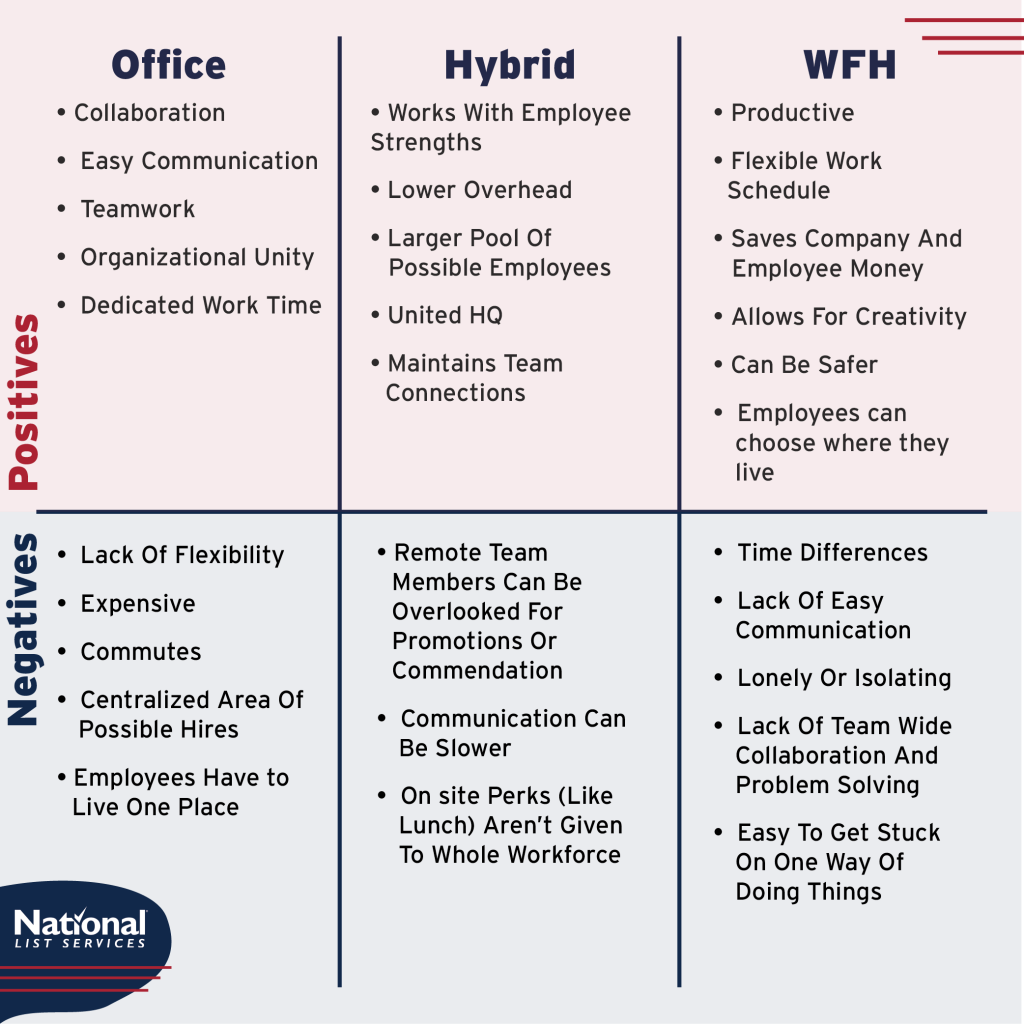
How has the changing work model impacted Flow?
One of the main advantages to a hybrid work model or allowing employees to choose weather or not they WFH, is that help each employee work in an environment that best suits them. Some employees can tap into their Flow State best in a quiet, comfortable space; weather that be at home or in the office, free of home’s distractions such as children or pets. Others like the background noise of a coffee shop. Some enjoy the collaboration of working in the office and having coworkers around them.
This year has given a lot of people an opportunity to find which type of work environment actually works best for them. Of the over 1,200 employees and 133 executives surveyed in Microsoft’s WFH study at the end of last year, 55% said they would prefer to still work remotely at least 3 days a week. And before this past year, many of those people probably wouldn’t have been given the chance to know what work environment worked best for them.
And how can you access your Flow State and increase productivity?
Here are the 2 main steps needed to tap into your flow state.
- First, you must observe yourself. For the next two weeks, observe yourself, notice what you’re doing, and look for the clues of flow: losing your sense of time or self, feeling that you’re acting with ease, gaining new insights, and having a positive feedback loop.
- Then, when you are in a state of flow, broaden your awareness: Notice and remember the activities surrounding you. Recognize what you’re physically doing and think about what you’re doing mentally.
What ways have you found to be effective in “getting in the zone” and accessing your Flow State?
Is the current office model outdated?
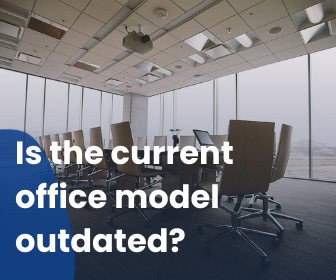
Remember like, a year ago when lots of big businesses were saying they weren’t going to require their employees to go back to the office? And then, inevitability they did. A lot of big companies and whole industries (like, banking and wall street,) have gone back to the office. What did we learn from corporate’s ‘year-at-home’? Are industries and office culture really going to adapt to modern WFH life? Or is the 9-5, 5-day-workweek here to stay?
Advantages of WFH
At the start of the pandemic, many companies feared that working remotely would cut done on productivity. After a year, that has proven not to be the case. Many employees feel more productive working remotely. 82% of senior executives surveyed reported seeing productivity levels either stay the same or increase because of working from home. WFH has cut down on something surprising: innovation.
82% of senior executives surveyed reported seeing productivity levels either stay the same or increase because of working from home.
WFH lowers office costs and shortens commutes. Employees like the freedom. 69% of respondents to Microsoft’s WFH survey said that the main reasons liked working remotely were: dressing more casually, being able to personalize their workspace, and having their pet by their side. Working from home also cuts down on casual workplace interruptions. That same Microsoft study found that before WFH, workers felt like 52% of their workday was wasted due to unnecessary disturbances. That number has fallen to 41% since the beginning of the pandemic.
Michael Parke, a professor at the University of Pennsylvania, who worked on the Microsoft study, said: “It seems that employees are able to hunker down and get less distracted while working remotely… However, the cost seems to be a loss of sense of purpose, which at work, is largely driven through strong and cohesive relationships and seeing how your tasks have impact on others.”

“However, the cost seems to be a loss of sense of purpose, which at work, is largely driven through strong and cohesive relationships and seeing how your tasks have impact on others.”
Michael Parke
Disadvantages of WFH
Working remotely means it’s hard to connect with coworkers, both for formal communication as well as for personal connections. This has had a direct impact on companies’ ability to innovate. The Microsoft study reported that the percentage of leaders who felt that their companies were innovative dropped 16% in 2020. Without sharing a physical space brainstorming and collaboration is more difficult. It’s harder to come up with new ideas as well as enact them.
The overnight and “temporary” switch to working remotely has created many challenges for employers and employees alike. WFH on this scale is such a new thing that solutions to challenges and long-term repercussions are still very much unknown. Being aware of challenges as they come up is the only way for companies to work on effective solutions.
What About A Hybrid Office?
As companies transition back to the office, many bigger companies aren’t seeing it as all or nothing: office vs. WFH. Many companies are trying a hybrid workplace. For example, the London based bank, StandardCharter is pushing and incentivizing a hybrid office model across its global offices. They plan to create smaller office hubs and give employees the choice to work at the office or at home. They are suggesting that employees meet at the office regularly to check in and collaborate. Building We-Work style office spaces will help solve technology deficiencies in their branches in developing countries and will lower costs across the board.
Facebook is also moving to a more hybrid work model. However, they are allowing it more than promoting it. Their current policy is that any full-time employee can request to WFH. Some jobs such as data center maintenance and hardware development will not be allowed to work remotely. They are also planning to adjust salary based on where you decide to work. It is a lot cheaper for the employee to work remotely from a city in the Midwest. (For example, the cost of living in San Francisco, CA is 199.8% higher than it is here in Omaha, NE.) Facebook is going to open all their US offices up to 50% capacity in the fall. Meaning, that almost 30,000 employees will continue to work remotely.
How has the last year of WFH impacted entrepreneurs?
Many people took the opportunity of disrupted work to start new businesses. Many people liked the freedom and flexibility that working from home offered and decided to leave their corporate jobs and pursue entrepreneurship.
“Americans submitted an average of 111,000 applications for new businesses per week between the end of June 2020 and the beginning of September 2020, the most applications submitted per week since 2007.”
U.S. Census Bureau
How do many people feel about going back to the office?
A lot of banks and tech companies went back to the office last week. How do their employees feel about it after working from home for a year and a half? Of the over 1,200 employees and 133 executives surveyed at the end of last year, 55% said they would prefer to still work remotely at least 3 days a week. Along with the loss of flexibility and other perks WFH offers, going back to working surrounded by people can be daunting. A scary as it may be, it will show your employer and teammates your commitment to your job and flexibility in dealing with transitions. Which will be really appreciated! If you are feeling anxious about the return, talk to your boss. Your company may be more open to a hybrid office than you think.
There is never going to be a complete consensus to the question: is WFH better? Every business, every office, and every employee will have a different opinion and method that works best for them. It doesn’t really matter what your company decides to do, as long as it’s the right fit for you.
Do you think a hybrid office is effective?
What Tasks Should You Delegate To Other Businesses?
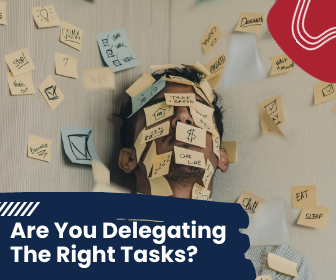
Our podcast, BeGrowthDriven, this week was all about things that are valuable to delegate to other businesses. Here the 5 things that we (and our guest Joe Camacho) found to be at the top of the delegation list!
Why Delegation?
We aren’t talking about just task delegation here. The delegation we are talking about is bigger than that. It can be easy an entrepreneur to try and wear all the hats yourself. We get that. However, there’s a lot of things that aren’t, uh, necessarily in your wheelhouse that can suck up a lot of time and effort. Delegation or farming out those tasks can free up your time so you can focus on the things you need to do to grow your business.

A lot of people hesitate to delegate some of these tasks because they think that if take care of it themselves, it will save money. That’s not always true. Sometimes short-term saving has long term costs.
Obviously, every company has different specialties so the tasks that need delegating will be different. However, these 5 are things that often fall into the category of thing that small companies try to do themselves and then up regretting it later.
#1 All the IT stuff
In this digital age, some IT services are a requirement. If you don’t know how to set up behind the scenes of a website or cloud services, it can be very time consuming (and expensive) to learn. There are so many companies and entrepreneurs who focus on IT services and management. They can help! Having it don’t right in the beginning will make it easier for the future.
#2 Compliance
Every year more and more regulations are added to the internet. Regulations about data usage, cookies, accessibility, etc. There are even more regulations if you are in specifics fields such as the medical and health industry. If you break a rule you didn’t even know was there can have serious consequences! Delegating compliance services to a specialist makes sure you don’t have any nasty surprises down the road.
#3 Branding
Branding is more than just a logo. It’s the entire outward facing personality of your brand! It can be difficult to look at your brand objectively, which is one of the reasons while delegating branding is a good idea! A graphic designer or branding agency knows the right questions to ask to help you figure out who your brand is. And they know all the technical things that need to happen to make sure your branding has the pieces you need to grow your business.

#4 Web Design
There are soooooo many free (or cheap) web design tools out there and honestly, some of them are really great! However, designing a website can be a lot more complicated than it appears. There’s a lot of technical aspects behind the scenes. Things like DNS and Domain Hosting are time consuming to learn how to set properly. Web design can be overwhelming and frustrating if it’s out of your element and might be worth delegating.
#5 Digital Advertising
Digital advertising is a massive field. There’s digital display, and programmatic adverting, and social media. There are entire agencies that do only Facebook ads! It can be difficult to know where to begin with online advertising: What software should you use? What’s the right channels for your business? What creative will work best? How much money should you invest? Where should you send the traffic you acquire? Delegating your digital ads will help you make money!
Some of these tasks we do for clients but others we delegate out ourselves! The key is to know what’s the best use of your time.
Did we miss any good tasks to delegate? Let us know!
All The Things You Need To Boost SEO

SEO has proven over and over again that it is essential to growing (and maintaining) your business. However, it doesn’t often get the spotlight it deserves! So, here’s some things you need to know to boost SEO.
What is SEO?
SEO stands for search engine optimization. Search engines look at look at many site elements like structure and design, visitor behavior, content, and other external factors to decide how highly ranked your site should be in the results pages. SEO has become the catch all term for all things you can do to make your site look more appealing to search engines.
What are the advantages of good SEO?
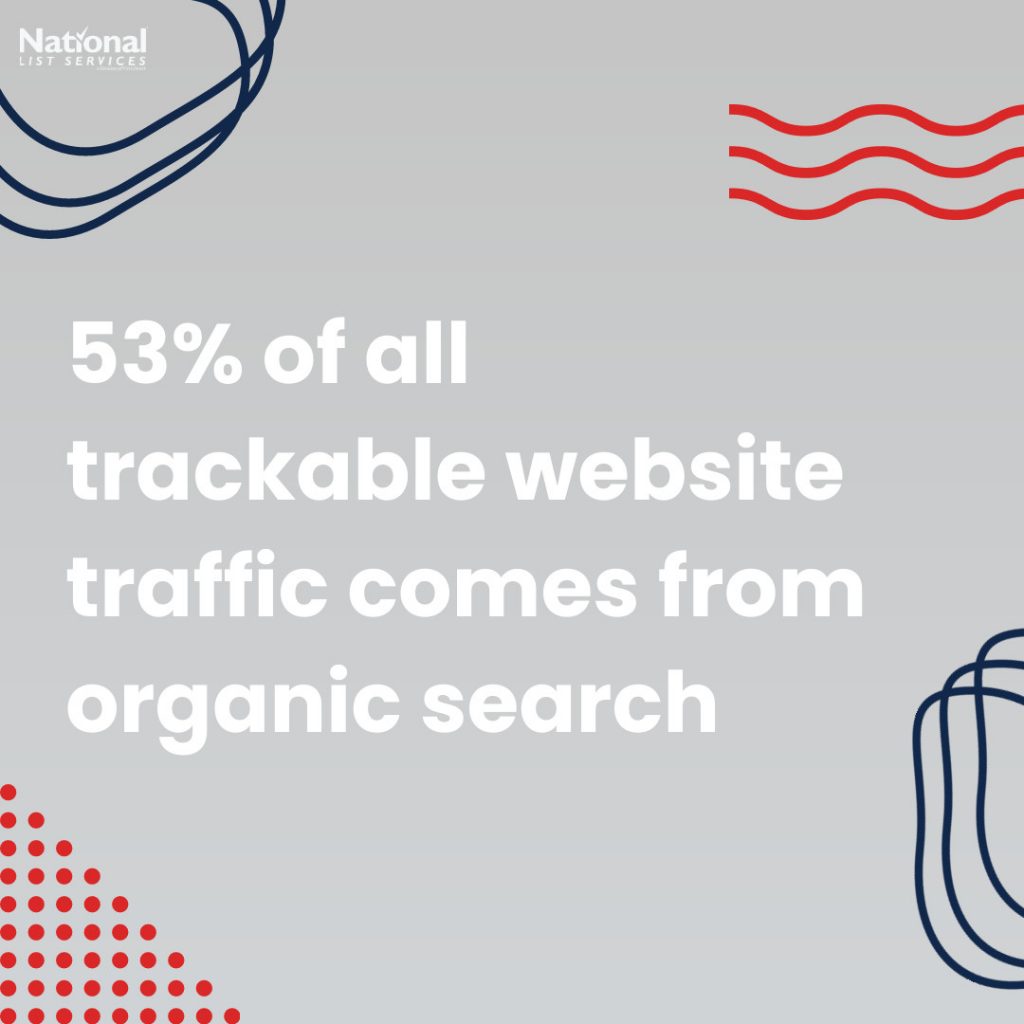
Good SEO gives your website credibility. It makes it easier for people to find your website when they search for it. And it helps create a smoother user experience.
The other important reason for making sure your websites SEO is up to snuff is that it helps generate organic traffic. 53% of all trackable website traffic comes from organic search. SEO is the main thing influencing how easy it is to find you online organically. Which is probably why it’s estimated that agencies and brands spent over $79.27 Billion on SEO services last year.
SEO is also important in driving local searches. When you search for “Best Pizza Place” near me, the results you are shown are based on the pizza place’s SEO keywords.
Where do you need to pay attention to SEO?
Everything “online” can be indexed and therefore optimized. Google indexes websites and apps that they own. So, your YouTube video search optimization is connected and combined with your website optimization. However, some companies, like Facebook, categorize videos and posts internally, meaning that it doesn’t help general search engine SEO.
What can you do to boost SEO?
Personally, I would split SEO into 2 main categories: Content and Categorization. Both are super important but require different things.
Content
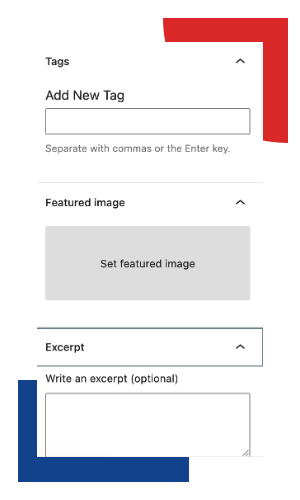
Content is all the things you put out there. Search engines look at what you are putting out there to determine your search rankings. Google likes blog articles and web pages with a lot of content. Adding pictures, videos, links, and charts shows search engines that what you are creating should be seen. They are going to rank something high in the search results if they don’t think its valuable.
To go along with that, search engines look at user experience. Is your website/blog easy to read? Do you have paragraphs, subheadings, punctuation, and spacing? Is it super short? (Long form content, over 2,000 words, tends to rank higher.) Do your pictures and video take a long time to load? How about accessibly? Do you have alt text for your images and text readers?
Search engines want to provide the best possible experience for its user and will rank your website accordingly.
Categorization
Categorization is all the “backend” stuff. Keywords, hashtags, blog categories, utm links, exerpts, and featured images all fall into this bucket. The best way to boost this type of SEO is literally just fill in every box provided. If the video you are uploading to YouTube as a field for title, description, keywords, hashtags, ect: give them that information! Search engines need to know what they are ranking, and all the backend information is how they know what it is and where it should go.
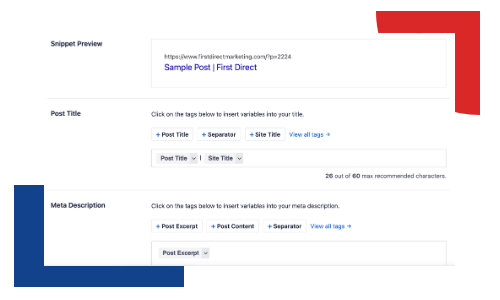
If you write an article called “How to make good pizza” the search engine will put with other information on pizza. However, if your article also has keywords like, “good pizza,” “how to,” “cooking,” “dinner for two,” “Italian food,” and so on, the search engine has a lot more places it can show the article.
Another thing you can do to boost SEO is to repurpose content. Search engines like to see a lot of content that revolves around a single topic. It shows a consistent brand message and purpose. A consistent brand message can indicate brand value.
What ways have you found to be effective in boosting SEO? Do you have a favorite method?
Be Your Own Brand Spokesperson – Why?
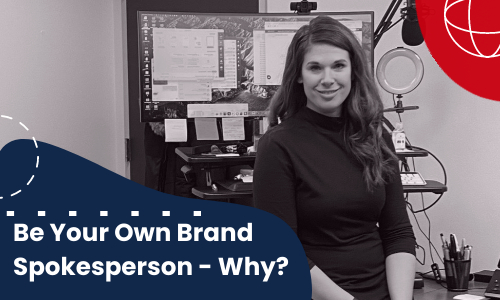
While branding your company most people focus on things like logos, colors, message. Which is all super important! However, in this visual digital world we are living, putting a face to the name (or brand, in this case) is very valuable. For example, pictures with faces in them are on average 38% more likely to get likes and 32% more likely to receive comments.
Here’s some specific reasons to use your face in branding and ways to do so!
Why Showing Your Face Helps Your Business
Here are 4 reasons!

- Using your face helps brand recognition
There’s a reason why brands use spokespeople. It is often easier for people to remember other people than it is to remember brands or companies. - It humanizes your brand
People like to work with people, not “soulless corporations.” Connecting your face to your company makes it easier for customers to relate to you and build an emotional connection. This is one reason why it’s helpful to use your face. Chances are that you and your company share the same values and goals. Having that message come from you and the company reinforces those ideals and helps other care about them too!
Another aspect of humanizing your brand is the trust that comes with it. It’s much easier to trust a person than a company; you know who they are and what they stand for. Linking you to your brand pulls that trust over.
- It creates engagement
Knowing who they are engaging with makes it easier for customer to connect with you on social media. Also, our brains are literally wired to find faces so putting your face front and center will help draw people to your content.
- It helps shape your community
This may sound confusing but linking your face and your brand can help create a more accurate and diverse business community. We all play a part in shaping the communities we are a part of. All of us have a story or journey to share. Highlighting your story along with your company story creates diversity. And you never know who your story will touch!
How to put your face front and center
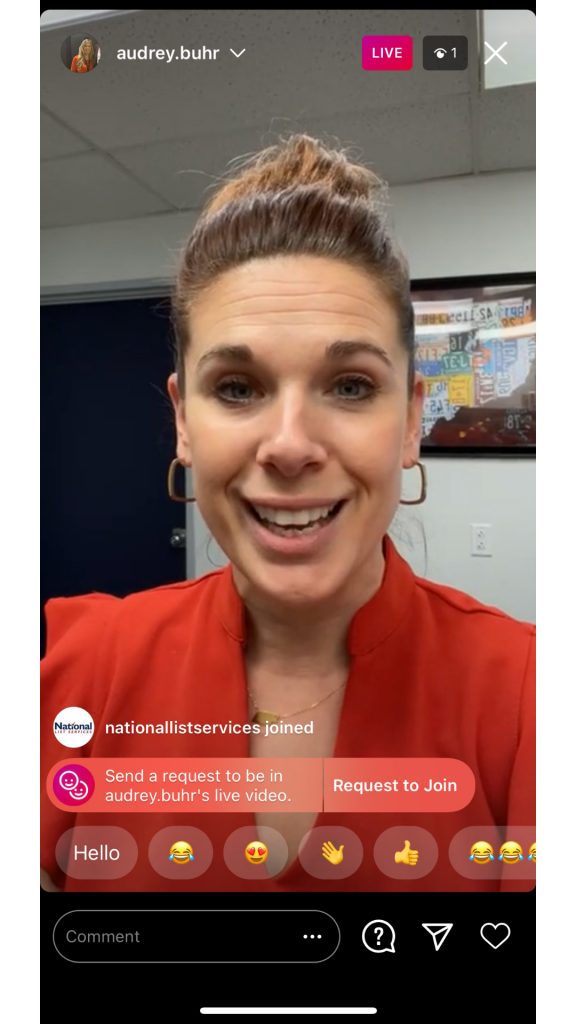
Here’s some tips to get started
Show behind the scenes
Pull back the curtain on your day to day. Everyone loves behind the scenes. Showing what you are doing is a good way to ease into using your face for marketing. It’s can be simple to do, just bring your audience along to your tasks! It’s a good way for people to get to know you and all the things you. It also can help your customers appreciate all you do!
Use stories!
Stories is a great place to show all those behind-the-scenes shots. It’s also a great place to speak to the camera about your company and your mission. Stories get a lot of engagement but disappear after 24 hours so there’s a lot less pressure! To make it easier on yourself, prerecord your videos. Make “eye contact” with the camera, don’t look at your own face. Have a general idea of what you want to say, a bullet point list helps! And don’t worry about any word whiskers. The point of this is to help people get to know you and show authenticity. It doesn’t have to be perfect!
Go Live!
You might be surprised by how much more engagement live videos get! Unlike prerecorded videos, live streams make viewers feel like they are a part of the conversation. The more authentic interactions create more engagement. For example, on average, live content generates 10x more the comments that prerecorded videos. And people tend to watch live content 10-20x longer.
We want to see your face! How do you connect your personal brand to your company brand?
Why Behavior Data Is The New Unfair Advantage You Need
 Two, 5 or maybe 10 years from now, the story of you and all the other companies in your industry will be exactly like Amazon vs. Walmart, Target, Sears, KMart, etc. There will be a couple who turned out sort of okay. There’ll be a lot of losers and one amazing success story. You can be the success story, and here’s how.
Two, 5 or maybe 10 years from now, the story of you and all the other companies in your industry will be exactly like Amazon vs. Walmart, Target, Sears, KMart, etc. There will be a couple who turned out sort of okay. There’ll be a lot of losers and one amazing success story. You can be the success story, and here’s how.
Everybody’s talking about mobile device data, big data and behavior data. But the real question is: How should you be using this data right now? (And yes, you should be.)
Think for a moment about how people act and what this tells you. For example, the armed forces know they’ve had a lot of success recruiting young people who:
- Have a veteran (or someone currently serving) in the household.
- Visited an armed forces website.
- Are taking some responsibility (looking for a job, getting a car or planning for college).
This is a great example of propensities. In this case, a person with a high propensity to join the military. People who behave a certain way are more likely to take an expected action. The more criteria they fit, the higher the propensity they have (the more likely they are) to act.
Notice the first item (veteran in the house) is a simple demographic. Marketers have known about and used demographics for years. And what about the website visitors? Cookies and targeting pixels can often be matched to specific people with their consent. (They entered their email, filled out a form or requested information.)
But what about the last item? Back in the day, there were only desktop and laptop computers. Now, almost everyone uses their mobile device.
Keyword tools can tell you what searches people type into Google. But can you see how the apps people install on their phones tell you so much about them? They tell you people’s lifestyles, habits, even the purchases they are about to make.
How can you use this information? Well, you could make a list of certain apps and target anyone who uses them. One little problem with that: tons of brand new apps are popping up on people’s phones every day. Your criteria is obsolete before you can use it.
How can you solve this? Categories. Every app falls into a finite number of categories. In the example above, some apps fall into the job-seeking category. Other apps are for college planning.
If you sell cars, imagine how useful it would be to know that someone in your area is searching for a car right now. Either on your lot or a competitor’s. Even if they’re searching for Fords and you sell Chevy – wouldn’t you like to know about them? And as you can see, behavior data not only tells you who – but can tell you when to make people offers.
It gets better. To get the best deals, consumers are happily revealing their location through their devices. And even the purchases they make. Can you see the opportunities here?
Yet there’s another reason you should be using behavior data now. Earl Nightingale, one of the first business philosophers said something really powerful:
“If you really want success…you can get a head start by looking at what everybody else is doing and do the opposite.”
It’s strange advice for those not familiar, but it’s a great strategy for those who are serious about improving their business. Let’s deal in reality here. Most people want 100% certainty before they dive into a marketing method. (And most people make excuses instead of progress, too.)
Mobile device data, behavior data and propensities are still new. And yes, there will always be a bit of unknown in any marketing strategy. Yet the risk behind behavior data is far lower, far safer than just using demographic data or all those marketing tactics people used in past decades. When you use methods like behavior data to narrow your focus and target a specific audience, you don’t just get a little better – your marketing gets exponentially better.
Not everyone will act on this. Some will just talk. Others will wait and see. And that’s why some companies will sort of do ok. Most of them will fail. And only a few will win big.
What will you do?
| Click here to learn more |
Save 80% Time & Money: How to Market to the Crucial 20%
 Wouldn’t we all like to save 80% of our time, money and marketing effort, while getting 10 times or even 100 times the results?
Wouldn’t we all like to save 80% of our time, money and marketing effort, while getting 10 times or even 100 times the results?
However, that’s just what Cara accomplished. Let’s see how she did it, and how easily you can do the same.
Starting out, Cara did what most failing marketers do… she found a “deal” renting a cheap list of 5000 prospects for 20 cents per name. It cost her an extra dollar per person to get the offer in front of her list. Total cost: $5500. Since 40 people bought her product at $100 profit each, she got $4000 back for her effort.
Poor Cara. She lost $1500 on this campaign. (Okay, I rounded the numbers, but this is really close to what happened.) Sadly, she thought her target audience should be “everyone interested in my product.” But the school of hard knocks really motivated her to take a closer look at buyer personas and exactly who her ideal audience is.
“What things do I need to look at to find my ideal customers?” Excellent question, Cara.
Fortunately, she found a great data provider who guided her through modelling tools and buyer propensities. Cara selected a list of only 500 prospects. Sure, these extra data analytics cost $2 per name instead of 20 cents each. Was it worth it?
Well, considering she spent the same dollar per person to get her offer in front of the new list, her total cost was $1500. This time, she sold to 30 people, making sales totaling $3000. Yay for Cara! This time, instead of losing, she doubled her money.
Really though, she saved 73% of her marketing cost. And she converted 7.5 times as many prospects into sales. But, you may say, how could you get 100 times the results? Another great question.
We’ve all heard of Mr. Pareto. The original 80/20 guy. Truth is, his principle can be applied to itself. Not only will 20% of your best prospects give you 80% of your profits… The top 4% of your prospects will give you 64% of your profits. (20% of 20% and 80% of 80%.)
Wow.
So, if you can identify the top 20% of your best prospects, you can really be 16 times more profitable. And if you identify the top 4% of your prospects…wait for it…you can be 250 times more profitable . If you are not following this formula, “you are leaving millions on the table,” says Brian Kurtz, Executive Vice President of Boardroom Inc. and leading direct marketing expert.
Don’t think it’s that valuable to niche down this much? Look at Amazon. They specialize in one tiny niche after another. And even a decade ago, that’s how they sold 50% of their books. Even small businesses can compete with large companies by targeting a smaller niche like this.
How can you make this easy for your business?
 Let’s say you’re the Dallas Cowboys. Most fans will get into the stadium for $19. Some of them will get $1000 season tickets for the mediocre seats. Only a few will get the $10,000 seats near the 50-yard line. And a tiny fraction of them will dish out far more money than this to enjoy the ultra-exclusive sky boxes. How much will a raving football fanatic (with money) spend on football? A virtually unlimited amount. You want to find THIS kind of people. And you CAN (and should) find them.
Let’s say you’re the Dallas Cowboys. Most fans will get into the stadium for $19. Some of them will get $1000 season tickets for the mediocre seats. Only a few will get the $10,000 seats near the 50-yard line. And a tiny fraction of them will dish out far more money than this to enjoy the ultra-exclusive sky boxes. How much will a raving football fanatic (with money) spend on football? A virtually unlimited amount. You want to find THIS kind of people. And you CAN (and should) find them.
Even if you’re only the company selling the peanuts.
Ask yourself about demographics: Who are your best customers? How old are they? Where do they live? What about their gender, income level, education, family/marital status, occupation and ethnic background? Now, ask yourself about their motives. What makes them buy? What is their personality, attitudes, values, interests/hobbies, lifestyle and behavior?
How can you know this stuff?
It’s not as hard as you might think to learn the right way to use a propensity modelling tool. Or some brand new (and yet relatively inexpensive) methods to give you real behavior data on your ideal customers.
Stay tuned.
Or better yet, call us. We’re happy to walk you through our tools right now.
| Click here to learn more |
